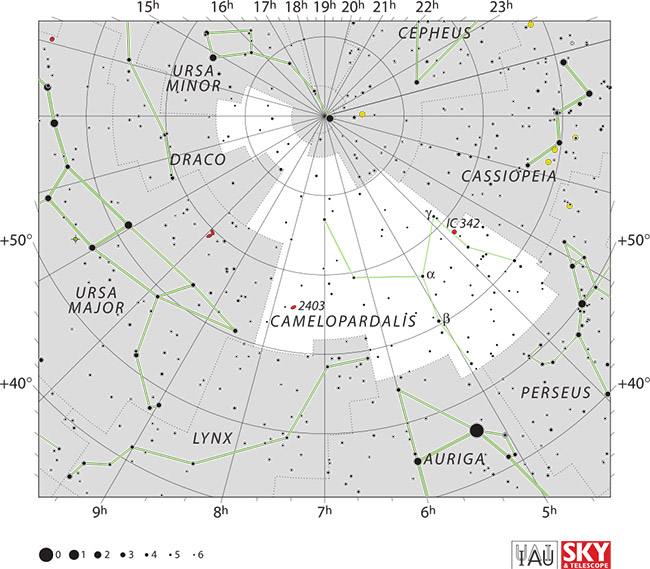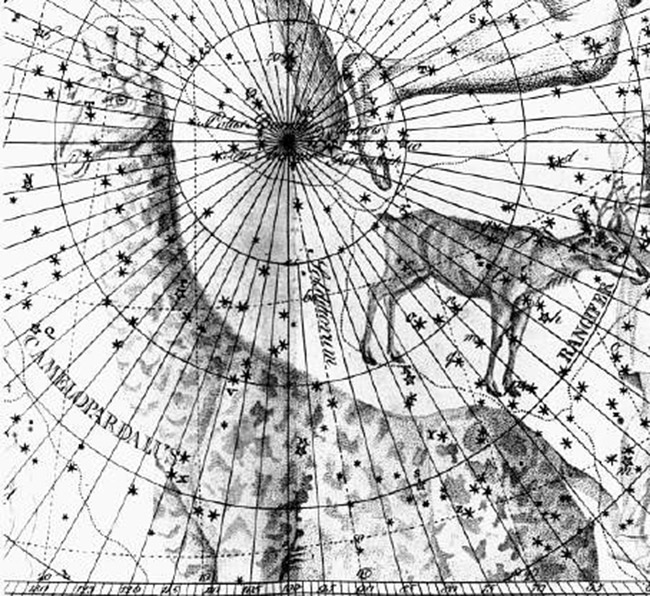Camelopardalis – Constellation Facts

Camelopardalis is the 18th largest constellation covering 757 square degrees in the second quadrant of the Northern hemisphere. It can be viewed specifically at latitudes between +90° and -10°. Camelopardalis represents the giraffe, which was once known as a camel-leopard (it has a long neck like a camel and the spots of a leopard). For this reason it actually gets its name from the Latin derivative of the Greek word for giraffe; camel (Greek kamēlos) and leopard (pardalis).
Constellation Characteristics
Camelopardalis neighbors with the constellations of Auriga, Cassiopeia, Cepheus, Draco, Lynx, Perseus, Ursa Major and Ursa Minor. Camelopardalis has no Messiers, but it does have three stars with known planets and the meteor shower called, The October Camelopardalis.

IAU and Sky & Telescope magazine (Roger Sinnott & Rick Fienberg), CC BY 3.0, via Wikimedia Commons
By IAU and Sky & Telescope magazine (Roger Sinnott & Rick Fienberg) CC BY 3.0, via Wikimedia CommonsPlanetary Systems
Camelopardalis is home to many deep sky objects, including galaxies and an open cluster. Check them out;
- NGC 2403 (Caldwell 7): located eight million light-years away this wonder is classified as an intermediate spiral galaxy. It has a Northern spiral arm that connects to a nebulous region in an external galaxy, also located in Camelopardalis. In addition, two Cepheid variables were also discovered here, making it the first galaxy discovered beyond our local group with Cepheid variables.
- NGC 1502: this small open cluster is located at the end of Kemble’s Cascade (discussed later). It only contains 45 stars, with a bright binary at its center.
- NGC 2366: notable for its star forming region (NGC 2363) NGC 2366 is catalogued as an irregular galaxy.
- NGC 1569: this dwarf irregular galaxy is situated 11 million light-years away. It is known for two super star clusters, with star forming activity. The cluster located in the Northwest region contains “young” stars that were formed less than 5 million years-ago. The cluster near the center contains more old stars, red giants and supergiants.
- IC 342 (Caldwell 5): although difficult to view because of interstellar dust, this intermediate spiral galaxy lies 10.7 million light-years away. In addition, IC 342 is also one of the two brightest galaxies in the IC 342/Maffei Group.
Main Stars
The constellation Camelopardalis contains only four significant stars, but also has one asterism making up its configuration.
- Beta Camelopardalis is the brightest star in Camelopardalis (which will be discussed later in detail).
- CS Camelopardalis is a binary star and is the second brightest. It is made up of a blue-white B-type supergiant and a Alpha Cygni type variable star.
- 1694 Camelopardalis (Sigma 1694 Camelopardalis, Struve 1694) this binary star represents the head of the giraffe and is made up of a white A-type subgiant and a spectroscopic binary (consists of two A-type main sequence stars).
- VZ Camelopardalis is located 410 light-years away and is considered a M-type red giant
Kemble’s Cascade forms a straight line with 20 stars. It spans approximately five moon diameters, ending in NGC 1502, which is an open star cluster.

The top half of Camelopardalis, shown on Chart III of the Uranographia atlas of Johann Bode (1801)
The top half of Camelopardalis, shown on Chart III of the Uranographia atlas of Johann Bode (1801)Most Shining Star
Out of all the stars that make up the Camelopardalis constellation, none shine brighter than Beta Camelopardalis. It is around 1,000 light-years away and is binary in nature. Its primary component is classified as a yellow G-type supergiant.
Mythology & History
This constellation was only created in the 17th century, as the Greeks thought this area of the sky was empty. Camelopardalis also has no mythology surrounding it and the story associated with it this constellation is considered unlikely. Some believe Camelopardalis may reference the Bible’s book of Genesis, most specifically, the animal in which Rebecca rode into Canaan (she was to marry Isaac here). However, the animal was not a giraffe, but rather a camel, so this story seems far-fetched.
Camelopardalis is a fascinating constellation, so the next time you are gazing into the night sky be sure to search out this intriguing figuration of stars.
